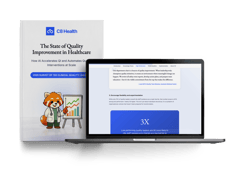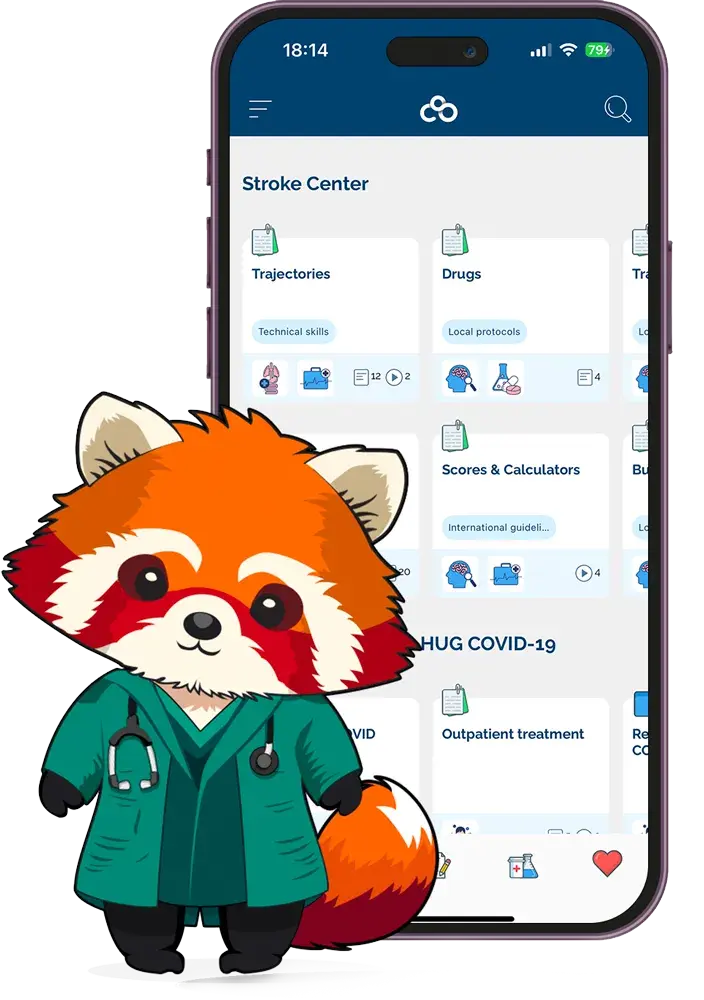
Implementing Best Practices for Knowledge Management in Healthcare
We're all facing information overload these days, and hospitals are no exception. [1] Providers need to treat patients effectively, but the crucial details are trapped somewhere between countless emails, folders, and clunky intranet pages. There has to be a better way to organize, right?
Knowledge management in the healthcare industry makes sure that the correct information reaches the right people at the proper point of care. [2] But the key to it being successful is implementing it correctly. That's why we've prepared a list of best practices you should stick to.
» Try the latest innovation in healthcare knowledge management
1. Centralizing Information
At the moment, a lot of healthcare organizations share information by email, meetings, or word of mouth. Centralizing it means having all types of content in one place. This approach creates a single, reliable source of facts for all administrative, clinical, and educational needs.
Hospitals need to integrate this central repository—or knowledge management system—into providers' workflow, quickly helping them access the information they need.
A centralized repository is the most efficient solution to close this healthcare gap. Finding answers becomes seamless with one source of clinical, operational, administrative, practical, and educational information.
C8 Health is an app and web-based knowledge management system that can easily organize, manage, and disseminate your organization's best practices. Your staff can use natural language queries to simplify the search and retrieval of clinical content with the help of an AI Assistant.
2. Vetting Local Knowledge
Having a central repository for knowledge only works if it's filled with information you trust. That's why local vetting is necessary.
The system needs to have data relevant to your facility approved by someone you know and trust. This step is crucial in acute settings where you don't have the time to research.
» Learn how comprehensive knowledge management can contribute to positive patient outcomes
3. Integrating With Workflows
Healthcare professionals need to be able to access the information they need directly from their workspace. The knowledge management system should fit seamlessly into their daily routines.
With this approach, the staff gets quick and efficient access to information, no matter whether they're working in a stationary setting-general ward-or an acute setting, such as the ICU. By eliminating time-consuming searches, you're improving efficiency and patient care.
» Find out how to optimize onboarding workflows with AI
4. Breaking Departmental Silos
Separate systems for educational, clinical, operational, and administrative materials create silos. They make it harder for healthcare professionals to access the information they need. Since medicine is a multidisciplinary field, everyone should have access to the entire knowledge base.
For example, a patient with multiple chronic conditions might need coordinated care from cardiologists, endocrinologists, and nephrologists. In that case, breaking down information silos improves efficiency and the outcome.
5. Differentiating Knowledge for Specific Sites
A healthcare provider may work across various sites, each with separate policies and procedures. That's why it's important they understand the specific best practices relevant to each field they work at, and knowledge management can help you ensure it.
So, if there's a protocol proven to improve patient outcomes, the system should quickly implement it across all sites. This way, you ensure everyone has access to best practices, which improves operational efficiency.
» Discover 3 additional strategies for effective knowledge management in healthcare
Implementing Knowledge Management in Healthcare: Challenges
- Leadership and Culture: Shifting to a knowledge-sharing culture requires strong leadership and a willingness to break down silos. [3] Providers with a more traditional mindset might be resistant to new ways of working.
- Technology Infrastructure: Often, implementing effective knowledge management systems demands investment in new technology or upgrades to existing software, which comes at a hefty price.
- Data Security and Privacy: Patient data is highly sensitive, and ensuring security and privacy of the software is crucial. You'll need to put in place strict protocols and access controls.
- Knowledge Capture and Contribution: Encouraging staff to actively contribute their expertise to the system is challenging. Those with busy schedules and a lack of incentives will avoid doing it.
- Content Management and Searchability: Organizing and fact-checking a large database of information is extremely challenging. Ineffective querying technology may also slow down searches instead of speeding them up.
- Lack of Methodology and Strategy: Before you even think about implementing a knowledge management system for your hospital, you need a proper strategy. Without finding a specific goal and creating steps to get there, you'll do more harm than good.
Benefits of Knowledge Management Systems in Healthcare
- Reduced medical errors: With knowledge management systems, healthcare professionals have quick access to evidence-based guidelines and protocols. They reduce the chances of medical errors. For example, software might contain specific dosing for medications, reducing the chance of an overdose. [4]
- Enhanced staff training and onboarding: According to research, continuous on-the-job training helps new employees adjust to the organization's culture and workflow faster. [5] Knowledge management systems can offer learning materials.
- Reduced costs: Improved efficiency through streamlined workflows and reduced medical errors can lead to cost savings. [6]
- Increased patient outcomes and satisfaction: With access to latest research and best practices, doctors can make informed treatment decisions. The results are faster recovery times and reduced complication rates, which leads to higher satisfaction.

Data-driven insights
Accessible best practices
Seamless integration into workflows
Role of Knowledge Management in the Healthcare Industry
Knowledge management in healthcare involves managing and organizing various types of information, such as:
- Educational: Covers residency curriculum, procedural videos, and exam materials.
- Clinical: Includes protocols and system policies & procedures for optimal patient care.
- Operational: Guides on how to operate medical devices.
- Administrative: Encompasses various forms for specific patients and situations, including setting and following up with schedules.
- Practical: Offers hands-on guides, case studies, and simulation exercises.
» Explore the roles and challenges of healthcare management
Boost Efficiency With Knowledge Base Management
An ideal knowledge management system for patient care functions as a central hub, providing a single, reliable source of truth accessible directly within healthcare professionals' workflows. This ensures everyone is on the same page with the latest evidence-based information.
Real-time updates and seamless integration should eliminate delays in implementing the most effective treatments. Powerful search and user-friendly interfaces make finding the correct information fast and easy, while robust security protects sensitive data.
Ultimately, this would help providers make informed decisions and deliver exceptional care, while also fostering patient engagement in their health. Intrigued?
» Store all your healthcare organization's guidelines in a single knowledge management system
FAQs
What are the 5 pillars of knowledge management?
1. People
Individuals who hold knowledge, the ones who need it, and the flow of knowledge between them. It's about fostering a culture of knowledge sharing and collaboration.
2. Processes
Establishing clear procedures for capturing, storing, organizing, retrieving, and applying knowledge.It is a roadmap for managing information effectively.
3. Content
Actual knowledge itself, including documents, presentations, best practices, and even tacit information captured from experts. It's the substance that fuels the knowledge management system.
4. Technology
Tools and platforms used to manage knowledge, such as knowledge bases, collaboration software, and document management systems. Technology helps make information accessible and searchable.
5. Culture
Overall values and attitudes towards knowledge within the organization. It involves encouraging sharing, valuing expertise, and creating a learning environment.
What are the 4 C's of knowledge management?
1. Creation: Generate new knowledge through research, innovation, and problem-solving activities.
2. Conversion: Transform knowledge into formats that are easily understood and shared, such as manuals, tutorials, or online courses.
3. Communication: Effectively disseminate knowledge to the right people at the right time, using appropriate communication channels.
4. Change: Encourage the application of knowledge to improve processes, solve problems, and drive innovation within the organization.
What is a simple example of knowledge management?
In healthcare, knowledge management is about capturing best practices and making them accessible. Imagine a clinic storing standardized treatment plans for a condition, like a recipe card for doctors. This ensures consistent care and saves time.
What are the 5 P's of knowledge management?
1. Purpose: This P highlights the need to define clear goals for your knowledge management initiatives. What specific problems are you trying to solve, and what outcomes do you expect?
2. People: Similar to the first framework, this emphasizes the human element.
3. Process: Here, it focuses on establishing efficient workflows for knowledge management activities.
4. Platform: This P refers to selecting the right technology to support your knowledge management strategy.
5. Performance: Tracking the effectiveness of your knowledge management initiatives is crucial. This might involve measuring things like employee knowledge sharing or the impact on project outcomes.
Resources:
- L. Sbaffi, J. Walton, J. Blenkinsopp, and G. Walton, "Information Overload in Emergency Medicine Physicians: A multisite case study exploring the causes, impact, and solutions in four North England National Health Service trusts," JMIR. Journal of Medical Internet Research/Journal of Medical Internet Research, vol. 22, no. 7, p. e19126, Jul. 2020, doi: 10.2196/19126. Available: https://www.jmir.org/2020/7/e19126/
- L. Shahmoradi, R. Safadari, and W. Jimma, "Knowledge management implementation and the tools utilized in healthcare for evidence-based decision making: a systematic review," Ethiopian Journal of Health Sciences, vol. 27, no. 5, p. 541, Aug. 2017, doi: 10.4314/ejhs.v27i5.13. Available: https://www.ncbi.nlm.nih.gov/pmc/articles/PMC5615016/
- N. Ali, A. Tretiakov, D. Whiddett, and I. Hunter, "Knowledge management systems success in healthcare: Leadership matters," International Journal of Medical Informatics, vol. 97, pp. 331-340, Jan. 2017, doi: 10.1016/j.ijmedinf.2016.11.004. Available: https://pubmed.ncbi.nlm.nih.gov/27919392/
- S. Hines, K. Kynoch, and H. Khalil, "Effectiveness of interventions to prevent medication errors: an umbrella systematic review protocol," JBI Database of Systematic Reviews and Implementation Reports, vol. 16, no. 2, pp. 291-296, Feb. 2018, doi: 10.11124/jbisrir-2017-003481. Available: https://pubmed.ncbi.nlm.nih.gov/29419613/
- E. Frögéli, B. Jenner, and P. Gustavsson, "Effectiveness of formal onboarding for facilitating organizational socialization: A systematic review," PloS One, vol. 18, no. 2, p. e0281823, Feb. 2023, doi: 10.1371/journal.pone.0281823. Available: https://www.ncbi.nlm.nih.gov/pmc/articles/PMC9934447/
- R. Hillestad et al., "Health Information Technology: Can HIT lower costs and improve quality?," RAND, Sep. 14, 2005. Available: https://www.rand.org/pubs/research_briefs/RB9136.html



